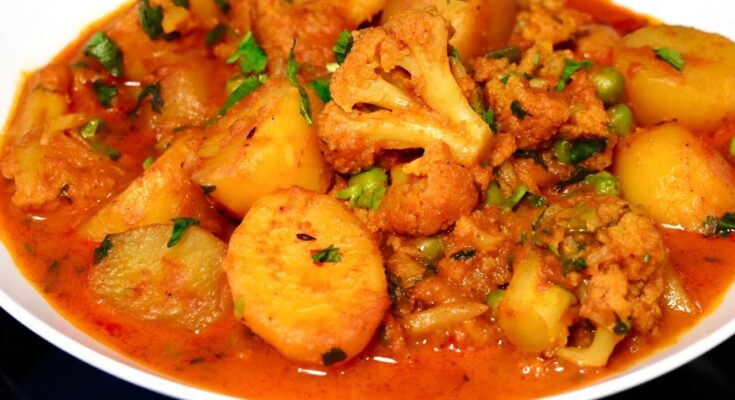Aloo Gobi Recipe: Aloo Gobi is one of those dishes that just hits home. It’s hearty, comforting, and packs a punch of flavor in every bite. Made with potatoes (“aloo”) and cauliflower (“gobi”), this North Indian classic is a staple in many households. You’ll often find it served at family dinners, lunchboxes, or even festive meals. It’s vegetarian, naturally gluten-free, and incredibly easy to whip up, which makes it a go-to for both beginners and experienced cooks alike.
What sets Aloo Gobi apart is its earthy flavor, thanks to a medley of spices like turmeric, cumin, and garam masala. The texture is another star here — crispy-edged potatoes, tender cauliflower, all wrapped in a spicy masala. Plus, you don’t need a whole pantry to make it. A few vegetables, some everyday spices, and you’re good to go!
Whether you’re cooking for yourself or trying to impress your friends with Indian cuisine, this recipe is a perfect introduction. It doesn’t need any fancy equipment or ingredients, and it tastes like something you’d get at an authentic Indian restaurant.
Origins of Aloo Gobi
Aloo Gobi hails from the heart of North India, with strong roots in Punjabi and Mughlai cuisines. Though simple, this dish has deep cultural significance. It’s often made during religious festivals and is a part of many traditional thalis. Over the years, it has spread across the globe — from Indian dhabas to Western kitchens — becoming one of the most recognizable Indian vegetable curries.
This dish embodies the Indian philosophy of turning humble ingredients into flavorful masterpieces. It uses minimal water and instead cooks the vegetables in their own steam, locking in the flavor and nutrients. That’s why, despite being such a simple dish, Aloo Gobi is a true gem in Indian cooking.
Ingredients Needed for Aloo Gobi
Fresh Vegetables
The stars of the show are, of course, potatoes and cauliflower. When choosing your vegetables, go for fresh and firm ones:
- Potatoes – 2 medium-sized, peeled and cubed
- Cauliflower – 1 medium head, cut into small florets
You can also throw in a handful of green peas or some chopped tomatoes if you want to add more color and nutrition.
Fresh ginger, garlic, and green chilies also elevate the overall flavor. If you like your food spicy, don’t hold back on the green chilies!
Essential Spices and Oils
Indian cuisine is nothing without its spices, and Aloo Gobi is no exception. Here’s what you’ll need:
- Turmeric powder – ½ tsp (for color and earthiness)
- Red chili powder – ½ tsp (adjust to your heat preference)
- Coriander powder – 1 tsp (adds depth)
- Cumin seeds – 1 tsp (for a nutty kick)
- Garam masala – ½ tsp (brings it all together)
- Salt – to taste
- Oil – 2 to 3 tablespoons (vegetable oil or mustard oil)
Optionally, you can add a pinch of asafoetida (hing) for an authentic Indian aroma, especially if you’re cooking in mustard oil.
Optional Add-Ons for Extra Flavor
Want to take things up a notch? Try adding:
- Tomatoes – 1 small chopped, for a slight tang
- Kasuri methi (dried fenugreek leaves) – a pinch, for restaurant-style aroma
- Lemon juice – a splash, right before serving
- Fresh cilantro leaves – for garnish
These optional ingredients can enhance the dish’s complexity and give it that extra restaurant-style finesse.
Preparation Before Cooking
Washing and Chopping Vegetables
Good prep makes the whole cooking process smooth. Start by peeling and chopping the potatoes into small cubes — this ensures they cook evenly. Cut the cauliflower into bite-sized florets. Wash both veggies thoroughly. If you’re worried about worms in the cauliflower, soak the florets in salted warm water for about 10 minutes before rinsing.
If you’re using tomatoes or chilies, chop them fine so they blend well into the masala. Mince the garlic and ginger or use a mortar and pestle to make a paste.
Prepping the Spices
Pre-measuring your spices is a lifesaver, especially if you’re new to Indian cooking. It prevents the panic of looking for masalas while your veggies are already sizzling. You can mix the dry spices in a small bowl and keep them handy. Also, keep your cumin seeds separate since they go in first for tempering.
A small prep tip? Lightly parboil the potatoes if you’re short on time. It speeds up the cooking process and gives you crispy yet fluffy potatoes inside.
Cooking the Perfect Aloo Gobi
Step-by-Step Cooking Instructions
Now comes the fun part — bringing it all together in the pan! Follow these steps for a foolproof Aloo Gobi:
- Heat the Oil: In a heavy-bottomed pan, heat oil over medium flame. Once hot, add the cumin seeds and let them sizzle.
- Add Aromatics: Toss in chopped green chilies, garlic, and ginger. Sauté until fragrant.
- Spice It Up: Add turmeric, red chili, and coriander powder. Stir for a few seconds, careful not to burn them.
- Toss in Veggies: Add the potatoes and cauliflower florets. Stir well to coat them in the spices.
- Cover and Cook: Lower the heat, cover the pan, and let the veggies cook in their own steam for 20–25 minutes. Stir occasionally.
- Final Touch: Sprinkle garam masala, mix gently, and cook uncovered for 5 minutes for a slight crisp.
That’s it! You’ve got a delicious, golden Aloo Gobi ready to go.
Tips for Perfect Texture and Flavor
- Don’t add water unless necessary. The natural steam from the veggies is usually enough.
- For extra crispiness, cook uncovered during the last 5–7 minutes.
- Want a dry sabzi-style Aloo Gobi? Skip the tomatoes. For a moist curry version, add ½ cup of water and a pureed tomato mid-way through.
- Always taste and adjust salt and heat towards the end — flavors settle better after the spices blend in.
Serving and Enjoying Aloo Gobi
Best Pairings (Roti, Rice, etc.)
Alright, you’ve made your Aloo Gobi and now comes the best part — eating it! This dish is super versatile when it comes to pairings. Whether you like soft breads or fluffy rice, Aloo Gobi plays well with almost everything on the Indian menu.
Here are a few top-notch serving suggestions:
- Roti or Chapati: The most common and traditional way to enjoy Aloo Gobi. It’s light, healthy, and perfect for scooping up those masala-coated potato chunks.
- Paratha: A stuffed or plain paratha makes the meal a bit richer and more filling — ideal for weekend brunches or cozy dinners.
- Rice: Steamed basmati rice with a side of Aloo Gobi and maybe some lentils (dal) is a complete, comforting combo.
- Jeera Rice or Pulao: If you want to elevate your meal, try serving Aloo Gobi with jeera (cumin) rice or a mildly spiced pulao. It adds another flavor layer without overpowering the dish.
You can also serve Aloo Gobi as part of a thali — a full Indian platter — with dal, raita, pickle, papad, and a sweet dish on the side. It’s a simple vegetable dish, but when combined with the right accompaniments, it feels like a festive feast.
If you’re going low-carb, skip the roti and enjoy it on its own or with a side salad — it’s flavorful enough to stand alone.
Garnishing Tips
You’ve done all the hard work — now let’s make it look as good as it tastes. Garnishing is key to elevating not just the look but also the flavor of your Aloo Gobi.
- Fresh Coriander Leaves: A handful of freshly chopped cilantro (coriander) adds brightness and a fresh aroma that cuts through the earthy masala.
- Lemon Juice: A quick squeeze of lemon right before serving gives it a nice tangy lift, especially if you skipped tomatoes in the recipe.
- Julienned Ginger: For a bit of zing and presentation, add a few ginger slivers on top.
- Green Chilies: If you like it spicy, slit a green chili and place it on top for that restaurant-style finish.
And here’s a little trick — a drizzle of ghee or butter at the very end (though not traditional) makes it extra indulgent and adds a silky texture to the dish.
FAQs about Aloo Gobi Recipe
Q1. What is Aloo Gobi made of?
Aloo Gobi is a classic Indian dish made primarily with potatoes (aloo) and cauliflower (gobi), flavored with turmeric, cumin, ginger, garlic, tomatoes, and a mix of aromatic spices.
Q2. Is Aloo Gobi vegan or vegetarian?
Yes, Aloo Gobi is naturally vegan and vegetarian! It contains no dairy, no meat—just wholesome plant-based goodness.
Q3. Can I make Aloo Gobi without tomatoes?
Absolutely. While tomatoes add tanginess, you can skip them or use a dash of lemon juice or amchur (dry mango powder) as a substitute.
Q4. How do I prevent the cauliflower from getting mushy?
Pro tip: Add the cauliflower later in the cooking process and avoid over-stirring. You want it tender, not sad and soggy.
Q5. What can I serve with Aloo Gobi?
It pairs beautifully with roti, naan, paratha, or steamed rice. Want to level up? Add some cooling raita or a side of pickle.
Q6. Can I store Aloo Gobi for later?
Yep! Store in an airtight container in the fridge for up to 3 days. Reheat gently to preserve texture and flavor.
Q7. Can I make it in the oven or air fryer?
Oh yes—roast the potatoes and cauliflower separately and then mix them with sautéed spices for a delicious twist!
Conclusion
There you have it — a full-on, flavor-packed, soul-warming Aloo Gobi recipe that’s as easy to make as it is to love. This dish is the ultimate celebration of simplicity and spice, turning everyday ingredients into something truly special. Whether you’re cooking for a busy weekday dinner or a relaxing weekend lunch, Aloo Gobi brings comfort, nostalgia, and deliciousness to your plate.
Don’t be afraid to put your own spin on it — add peas, tweak the spice levels, or make it saucier. That’s the beauty of homemade Indian food. Once you master this recipe, you’ll find yourself going back to it again and again.



